Kevin Durant’s newest Nikes draw inspiration from the energy of the borough, implementing the artist’s signature typeface to celebrate Kings County.
Throughout his career in the sneaker game, Kevin Durant has looked to bring storytelling and detail to his annual Nike KD series.
Whether that’s highlighting people close to him like his dear Aunt Pearl, celebrating some of his favorite childhood memories of playing on a Nerf hoop, or simply expressing his evolving interests over the years, the silhouettes have long served as a canvas for him to share his story.
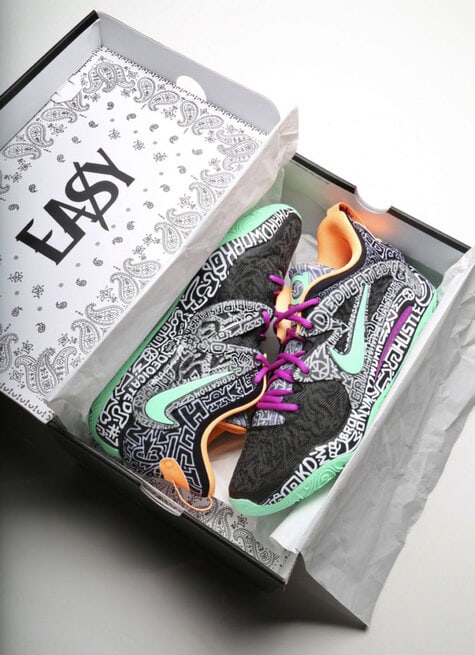
The KD15 has been no different, shifting from a PE honoring the late Virgil Abloh and his groundbreaking Off-White series with Nike to a trio of colorways designed by some of his favorite music producers.
“I’m switching the flavors up a little bit more than I used to in the past,” Durant said on a recent episode of The ETCs.
His latest pair celebrates his love for art and continues an ongoing collaboration with New York artist Timothy Goodman.
Known for his flowing typography and black-and-white contrast work, Goodman first helped style the Durant Family Foundation’s 21st court donation, with a vibrant blue, yellow and red design at P.S. 152 / 315 in Brooklyn.
For Goodman, who did his first font-based mural in 2011, the sneaker launch adds to the many projects and releases his celebrated work has earned him over the years.
In 2017, he created a 33-piece collection for Uniqlo that went on to sell over a million units globally in six months.
His work has been featured everywhere from corporate office settings to storefronts to even across garbage trucks for the NYC Department of Sanitation.
Over the last year, the tandem has created a new “Timothy Goodman” edition of the KD 15, with loud pops of neon orange, green, and purple atop the black and white canvas.
“I wanted to make something that I felt like was one of the dopest shoes that I’ve ever seen on the court and something that could live off of the court,” Goodman said of the starting point of the design.
“There was also the idea that it’s actually something you don’t want to wear because you want to put it on a shelf as a piece of art.”
Pairing together Goodman’s signature style, along with phrases and words representing KD’s time in Brooklyn and the surrounding community, art has once again served as the fuel for KD’s footwear.
“It plays a huge part. Music, art, and basketball, to me, I feel like it’s all the same art form,” KD said. “It’s something that resonates with me and I try to incorporate it in my shoe.”
To hear all about how the project came together and the inspiration behind the many details throughout, Boardroom caught up with artist Timothy Goodman ahead of the launch. Also, Boardroom has a chance for you to win a pair of your own – see the details below!
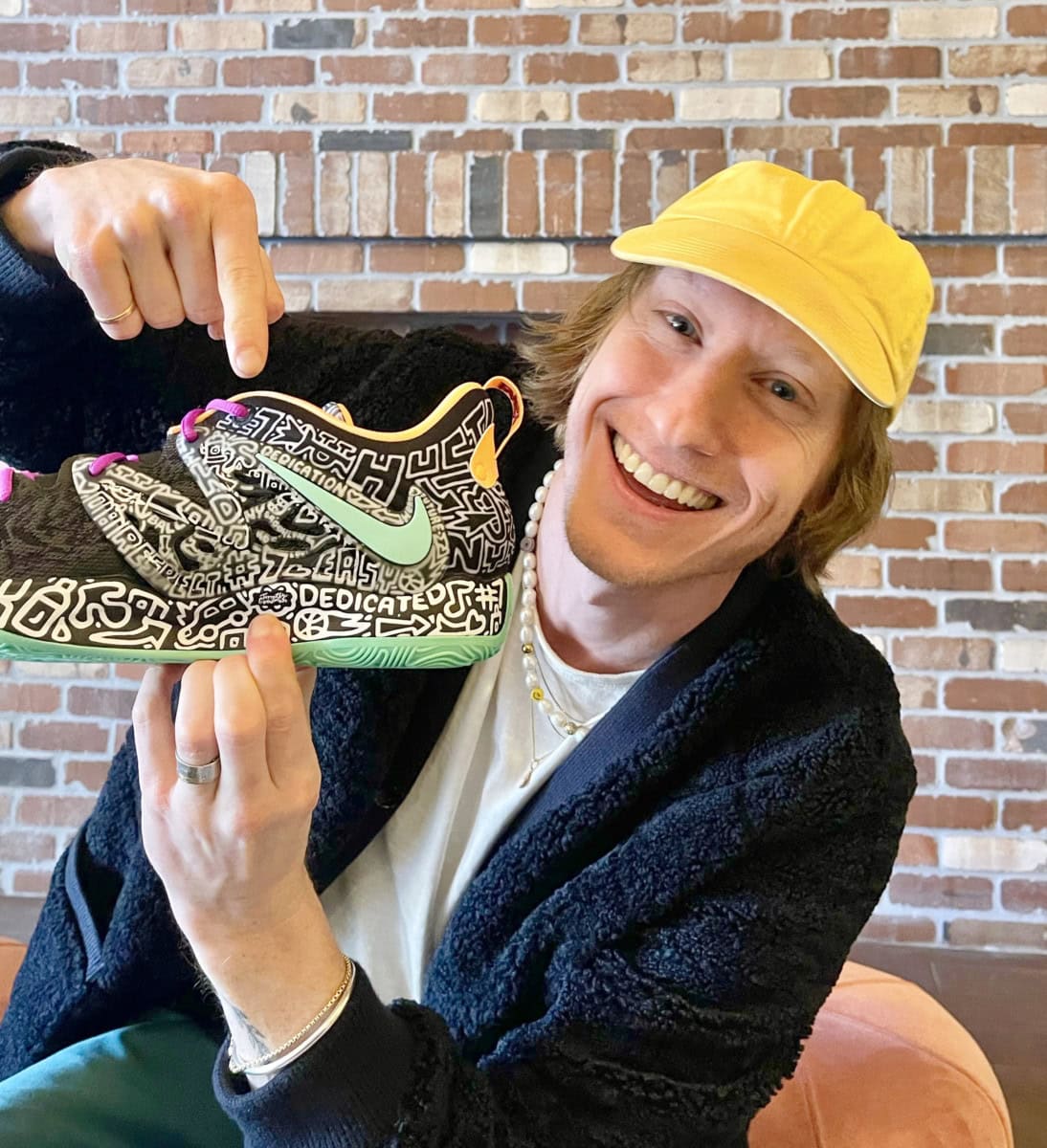
NICK DePAULA: What was the starting point of this project? Did you go from the court donation design to a conversation around doing a shoe?
TIMOTHY GOODMAN: It’s wild. Kevin said to the team, “Yo, we need to do something like the court.” I’ve worked with a lot of big brands, and a lot of times, people don’t value art, the craftsmanship that goes into it, and the actual artist that is behind something.
In a lot of ways, Nike could’ve said, ‘We love that court, we can just replicate that internally.’ Kevin wanted to get the artist, so Nike reached out and started with, “How would you approach this?” It was an incredible experience.
We started early in the pandemic in 2020. I was really specific in what I wanted. I didn’t want to just make a pattern that would get placed on, and then some shit gets cut off or it doesn’t fit just right. I wanted to really be intentional about it.
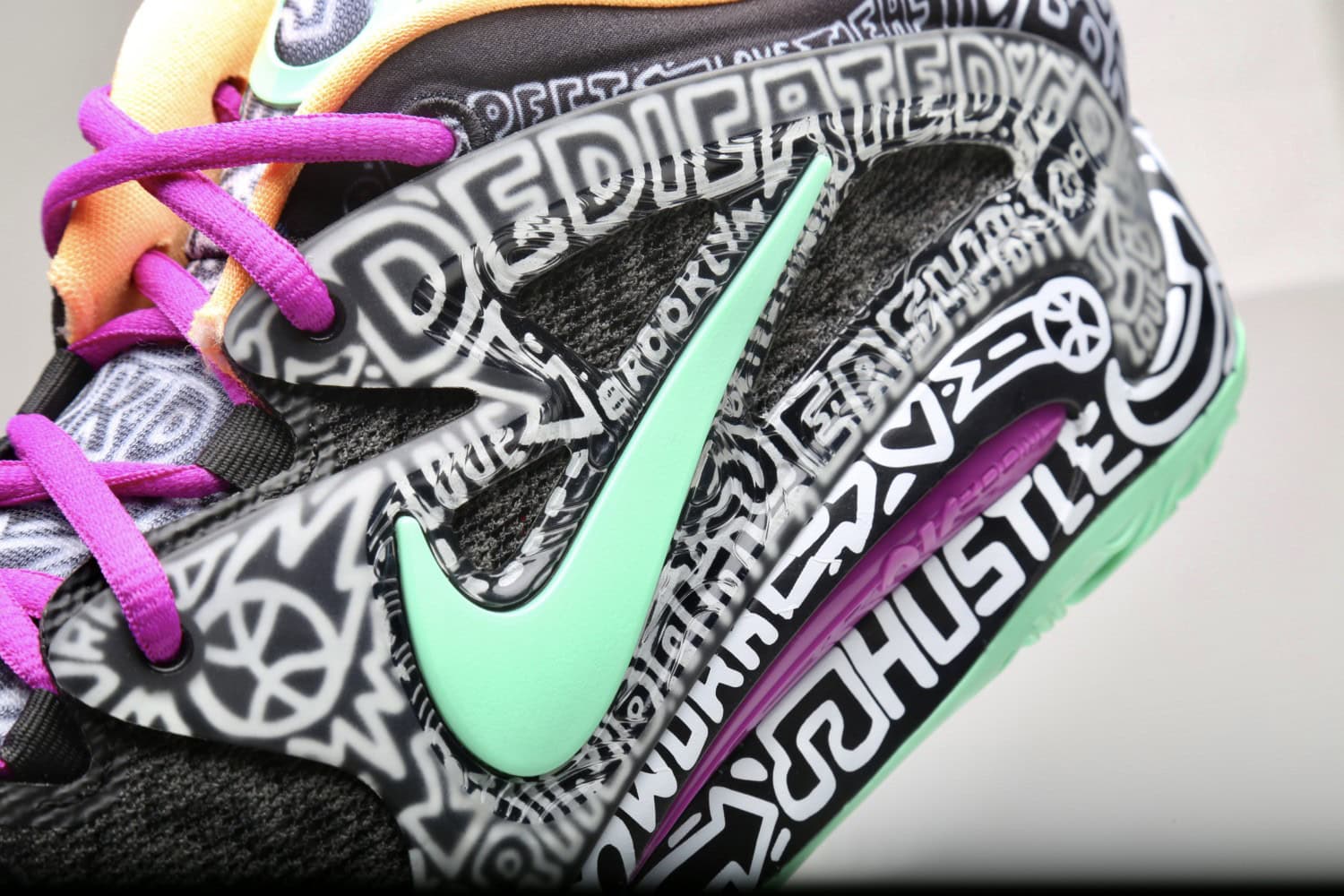
NDP: That’s the first thing that sticks out to me, is how expressive yet precise the shoe is. You basically had four panels, between the midsole, side panel, heel, and tongue. What’d you want to express?
TG: I wanted to make the dopest NBA shoe I’ve ever seen. There’s exceptions, but by and large, most NBA shoes aren’t something I would want to sport out in real life. They’re perfect for the court, but I wanted to make something that would be fresh as fuck for Kevin on the court, but also, I want to wear it with an all-black fit when I go out.
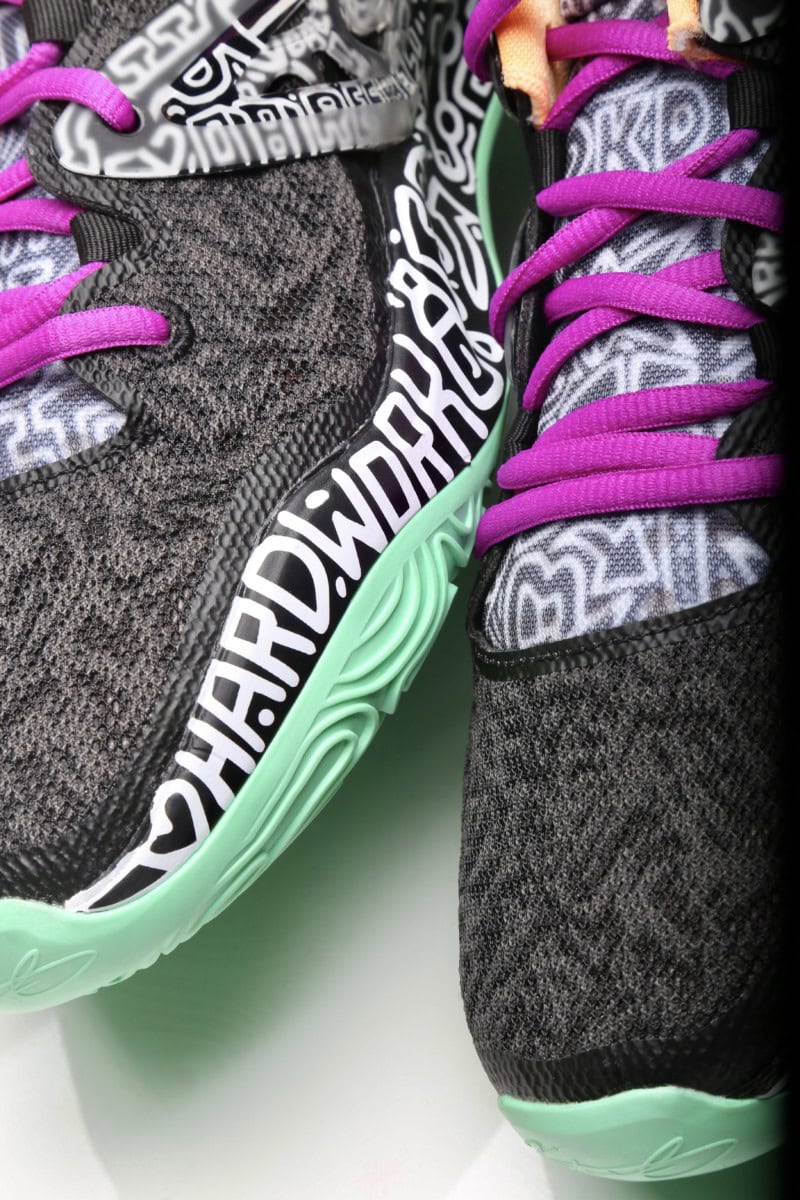

NDP: This shoe was also a bit of a departure for Kevin. He had some higher cuts in the past and went back to a Low here.
TG: I love that. And Nike and Kevin were so cool about letting me do my thing. We talked about a concept of capturing the energy of New York and the energy of Brooklyn through my voice. It was based off of the basketball court that I did with the Durant Family Foundation in Brooklyn, and the students at the school, P.S. 315.
NDP: What were some of the phrases and words that you wanted to incorporate into the court?
TG: I did two art workshops with the students at the school first, and I had them draw all of the things that they wanted me to draw on the court. They were the fuel and the inspiration for the things that I did on the court.
NDP: In terms of your start in being an artist, did you always have a font-based style, or how did you evolve your style?
TG: In some ways, I’m a descendant of Keith Haring. He had this very black-and-white, line-drawing style that all puzzle-pieced together. In a lot of ways, he’s a massive inspiration to me. My thing is, I went to graphic design school, and the lettering that I’ve learned, the typography and the words, I can also be editorial about the work.
What led to the basketball court that I did with the Durant Family Foundation and then led to these shoes, was a permanent installation at Bleacher Report’s office in New York. There’s a long wall that is still up, that’s an homage to my top 25 NBA teams ever. It was editorial in that sense, and I want to walk you through a story with my work. I also want it to be dope as fuck, and I want you to feel something that’s unique.

NDP: What’s it like seeing your work featured across products like this that’ll be worn on the biggest stage of the game?
TG: I think all art should be accessible, and that’s what I’m excited for. This is about community, and all of my work is rooted in how deeply I love New York and the people that came before me in the community that live there.
Yes, I do a lot of brand stuff, but so much of my work that’s just as important to me is pro bono, for organizations and for schools in New York and in Brooklyn. That basketball court, that’s their court. Those kids can say they have the coolest basketball court in the world.
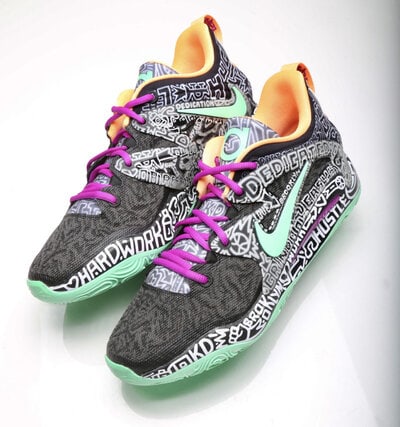
NDP: I always say, people don’t really understand the gravity that an elevated court can have. Growing up in Sacramento, we had these courts on 10th & P that the Kings had donated to and re-done when I was in middle school. It became this amazing spot for us as kids.
TG: There’s an ownership in that where you can say, “I got the dopest court!” Art, it becomes for the people, ultimately. Creating something that yes, is a basketball shoe and there’s a function to it, but also, I can take this and also put it on my shelf as a piece of art with my books too. Or you can wear it out, and people will stop you and say, “Damn, where’d you get that shoe at?” That’s what I’m in it for.
NDP: How does your art style come together as you’re going?
TG: We come up with a list of everything that we want to be included. This was done a little differently since we had to do it all digitally first and make sure it fit. It really depends on the format. This was really about capturing New York, and they let me do my thing. With these shoes, I wanted to capture the essence of the art so that it looks like it was just drawn on. It looks like I just came up with it with a Sharpie.
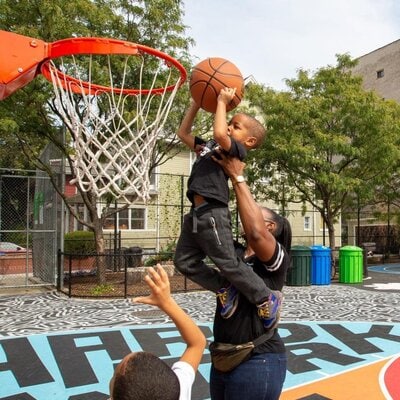
NDP: You said an 80-foot wall took you five hours – how long did the court take?
TG: There’s really two parts to the court. Inside of the 3-point line, there’s these wonky, larger words. That took maybe two days. Then, the freestyling of the black and white drawings that I did, that took another three or four days of work. With a wall, I start on the top left corner and then just work my way in.
I think a lot of it is like a basketball player, a freestyle rapper, or a jazz player – once you have put in your 10,000 hours and so many years, you form patterns in your head that become second nature. After doing it for so long, it becomes a pattern that you understand, and you have a set of chords that you break out and build into it. Understanding composition and spacing, so that it can all fit together, is really a pattern that you form from the practice over the years.
NDP: With the notion that you wanted to create something fresh to wear, is that also why you kept the toe angle a little more clean?
TG: With the mesh material, there was no real way to print onto it. I did some options with bigger handwriting across the toe, but it was just too much and too hard to print on. At first, I was thinking, “I want to get my art on everything.”
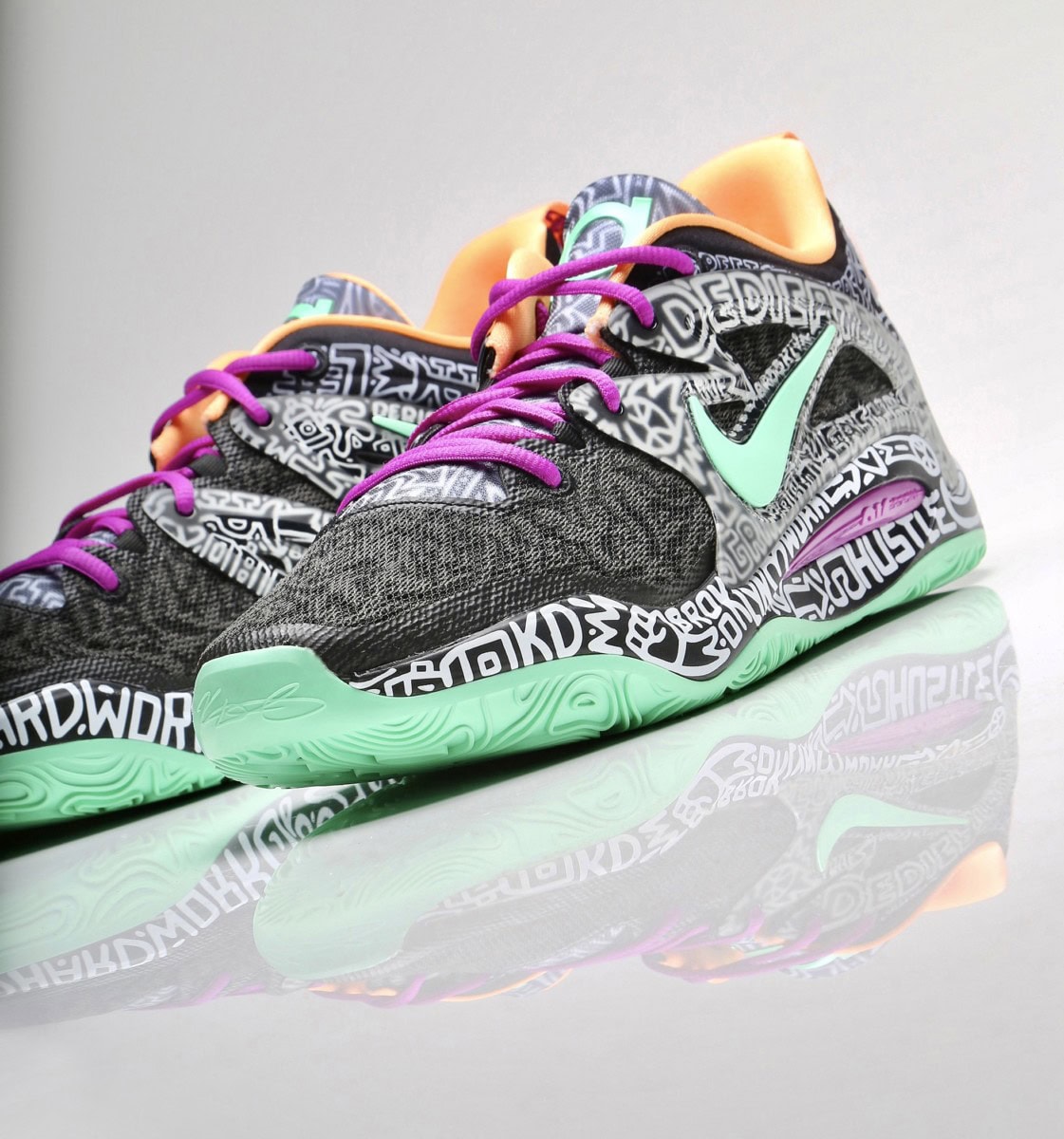
NDP: How did you land on the final colorway?
TG: They were incredible and let me pick the colors, too. I did about a hundred variations of color. I did a whole deck. One had black drawings on a white shoe and others had all of these different colors. I love the vibe of the 80s, and this is a New York-centric shoe for Brooklyn.
I wanted to capture how I think about old Spike Lee movies, or the neon colors from Nike back in the day, like these bright oranges and neon green. The Bo Jackson stuff and some of the vintage Nike shirts that I have. I really looked back at the 80s and 90s around the NBA, which is my era and Kevin’s era.
I also had done some all-black with white graphics, but it was too clean. Ultimately, Nike said, “Whatever you feel strongest about, let’s roll with that.” I said, “It’s gotta be this one.”

NDP: When somebody does a collab, sometimes it’s just a colorway and not distinctive enough. This is such a signature piece from your perspective, where your art is so directly relayed.
TG: Definitely. It’s also wild that I got my signature on this, too.
NDP: How did the key phrases come about to really encapsulate what you wanted to convey through the shoe?
TG: It’s really about resilience. Resilience on Kevin’s end, and resilience that I equate to New York and the people of New York. There’s also “Hard work,” “Dedicated,” and “Determined.” Things that capture hard work and resilience, which is how I think about Kevin and the people of New York and Brooklyn.
Read More:
- The 25 Best Movies of 2025: ‘Sinners’, ‘Friendship’, ‘Secret Mall Apartment’, and More
- Austin Ekeler’s Netflix NFL Analyst Role Previews Potential Post-Career Plan
- ‘It: Welcome to Derry’ Shows How Stephen King’s Universe Can Finally Interconnect
- Cam Ward Reveals His Mount Rushmore of Kevin Durant, Tom Brady, Kobe Bryant & More
- Cam Ward on His NFL Rookie Season, Building His Brand, and Life as Titans’ QB1